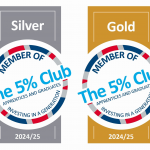By Chris Shirley, Apprenticeship Services Manager at Network Rail

MyKindaFuture, Grant Thornton and The 5% Club recently hosted an online event around how to remain reactive and agile during the current period of uncertainty, whilst allowing for attracting, hiring and on-boarding the best, most diverse early talent.
If you would like to view this event – please visit the ‘on demand replay’ section on our events page:
Here are the key points from this event we need to consider as we move forward:
- Simon Reichwald, Strategic Lead for Talent, MyKindaFuture
- Katie Nightingale, People Consulting Manager, Grant Thornton
- Chris Shirley, Apprentice Services Manager, Network Rail
In the first blog of this series myself, Simon Reichwald and Katie Nightingale looked at the potentially devastating impacts on the UK Skills gap of an ageing workforce, Covid-19 and Brexit all arriving at the same time. In the second of our reflections on this perfect storm we turn our thoughts to the uncertainty around academic qualifications, whether we are truly meeting the requirements of our apprentices and learners in the current climate and what the impact of these changes may be in the long term for the development of a skilled and productive workforce.
One of the most worrying aspects, particularly for those in education, has been the all but complete cancellation of academic assessment through examination, which leads us to the question whether apprenticeships are the most robust assessment of qualifications for 2020.
Prior qualifications (GCSE’s, A Levels, Degree classification) have for years dictated an individual’s access to opportunities. The evidence in recent years is that this is changing – 5 years ago 75% of graduate recruiters set a 2.1 degree classification as a barrier to apply, today it is just 57% (and only 16% use UCAS points as a minimum requirement). Anecdotal evidence shows us that over the past 5 years whilst graduate recruitment has remained fairly constant there has been a significant increase in the recruitment of apprentices, particularly at level 3 and more recently at level 6. This reflects both the changing nature of both business requirements and early careers choices. ISE data supports this which shows since the introduction of the levy there was a 50% increase in apprenticeship recruitment in 2017/18 and a further increase of 47% in 2018/19.
It is also true to say that strength based recruitment is on the rise, with 50% of Early talent recruiters adopting this approach and 69% using a mix of strength and competency based, as more and more employers seek to look beyond simply academic achievement and focus on the whole person.
Many consultancy firms have already abolished entry qualifications for apprentices and graduate roles and there is now evidence to show that those who would not have ordinarily been successful at the shortlisting stage under the previous criteria are now performing at the same or higher level to those who would have been successful at the shortlisting stage.
In the current climate the traditional assessment centres, with group tasks, Q&A sessions and face to face interviews are simply not possible. Whilst many organisations have used qualifications as initial sift criteria, then assessment centres for strength based selection there is now a fundamental challenge to this.
Assessment centres are used by 94% of Graduate Recruiters, and 80% of school leaver Apprentice Recruiters with a huge 90% reporting it as an effective way to select the right candidate, the next most effective at just 33% was face to face interviews. So with such an effective tool what can be done to make it, when done virtually, equally as effective?
From conversations the authors of this blog have had some big Early talent recruiters have made the decision to drop group exercises for virtual assessment centres (not just because the evidence shows them favouring extroverts) but in an increasingly virtual world those all round a table / in a room meetings may well be less common (so why test against that) and more likely are virtual meetings so lets train them for that!
We still don’t know what academic grading will produce for those students at every level who have been unable to sit final year examinations. This will make strength based recruitment selection more important going forwards to get the right match to roles and organisations – but how can this be done effectively if you cannot look into a candidates eyes, assess their body language or pick up on the non-verbal signals often seen in face to face selections. We also need to consider the fact that those not from a lower socio-economic background will have a head start potentially in virtual assessments as they may have more access to tech in a comfortable, private environment. How do we level the playing field if using virtual assessments more often? According to the ONS in 93% of households have internet access and 66% have mobile internet access – but that still leaves a significant minority who potentially do not have access to the system that we are now using as our main communication channel. How do we overcome this?
Getting your selection process right is more important than ever with how exams grades awarded this year, so yet another reason to move away from grades as ‘barrier’ to hire and if that assessment is critical to hiring then the only qualifications that will be formally assessed (through EPAs) this year are apprenticeships!
It will be interesting to see in coming years whether the class of 2020 proves to be identifiable within the workplace, or whether they fade into the crowd.
Once we have recruited our apprentices and graduates thoughts then turn to how those new recruits are trained and developed. Whilst we don’t necessarily have answers to the following questions, we believe that it is important for them to be asked and considered within organisations.
The first question we think that needs to be asked is whether the pivot to digital delivery has been too fast – can you honestly say that every learner has had the same experience, opportunity to participate or the same tools. It may be one thing to be able to show progress and measure attendance, but have you brought your apprentices (and all you employees) with you?
When it comes to remote working employers have proved themselves to be super agile and flexible with the message to employees to work from home, work the hours you need to and when you need to (so not tied to 9-5), BUT have we been less flexible with our apprentices eg training starts at X time and finishes at Y time?
That offer to access their training digitally was done with the very best intentions, so apprentices did not have to have a ‘break’ in their training, but how well have the multiple ways of learning been reflected in this? How engaged have your apprentices been on this swift journey into all virtual learning, when they may well not have signed up to that? Is more flexibility as to when training is done possible for apprentices to cater for those with less access to tech, with different learning styles or for those that have commitments outside of work that require flexibility?
The second question we would like to consider is what support have they had to adapt to new ways of learning, as we will all need to change as we adapt to the new normal. As we were in the process of authoring this blog a conversation with a Head of Early Talent resonated when they said “it’s not great tech I need (although that matters), it is ensuring the training programme is delivered to all my diverse talent with maximum effectiveness and impact.”
With such a fast switch to online / virtual delivery have we truly considered, or measured, the effectiveness of the new delivery models?
Feedback from many apprentices has been that although the pivot to Digital learning was initially useful, and indeed welcomed, as remote learning quickly becomes more embedded there is a realisation that this may now become the norm. From a financial point of view it certainly reduces the cost to businesses with a reduction in travel & expenses and less time lost to attend courses. However as many are pointing out a distance learning course was not chosen because many people learn as much from the other course delegates during breakouts, discussions and group working as they do from their trainers, is the benefit of others experience something that we are now losing out on during purely digital delivery? We also spend a lot of time talking about learning preferences or styles, often in face to face environments different learning styles are taken into account automatically during the duration of a course, how are your providers meeting different learning preferences through a laptop screen?
We believe that employers and providers need to be working to a true blended approach to learning, one that can flex with the learners needs wherever possible. This will increase the opportunities available to more people which will allow learning to fit with their lives, whether they are a carer, have physical limitations that prevent them from being present at certain times or they access to the right tools to learn is limited due to when these are available to them, i.e. sharing tech with family members or having to access at another location.
And finally have you considered those with additional learning needs? In a face to face environment quick interventions are possible, a word here – a diagram there, a conversation to support learners during or after a lesson – this is not so easy when delivering remotely – either to spot an intervention is required or to make it.
There is no doubt that the impact of Covid-19 will have far reaching impacts on delivery of apprenticeship programmes going forwards, but we must remember that the ultimate success of an apprenticeship programme is not in how it is delivered but by how successful the learners are.
Some questions to consider
1) How will you recruit those that are a best fit to your business if traditional routes are no longer available
2) How confident are you that your current / recently revised recruitment systems work without face-face interaction?
3) In a virtual world are your recruitment and training systems inclusive to all
4) Are the right skills being developed at entry level within the UK?
5) How will you support & develop apprentices, graduates and new starters in a more ‘remote’ working model?




